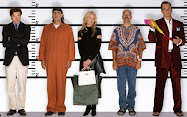
I've been reading The Making of 2001: A Space Odyssey (Modern Library Films didn't italicize the film's name...), and I recently read a few chapters chronicling Arthur C. Clarke's experiences before and during production. Clarke and Kubrick had such a wonderful kinship, one of intellectual stimulation and exciting curiosity and respect. Kubrick is famous for being a perfectionist, and Clarke even admits that, at times, he was ready to be done with the movie. He had allotted two years of his life for discussing, drafting, writing, and making both the novel and the film 2001, but it ended up taking over four years. It's exciting to read excerpts from Clarke's journals, and I've included some of the stranger and more interesting thoughts, not necessarily having anything to do with the movie.
May 31, 1964. One hilarious idea we won't use. Seventeen aliens -- featureless black pyramids* -- riding in open cars down Fifth Avenue, surrounded by Irish cops.Clarke was quoted in Newsweek as saying, "There is nothing we wanted to do we couldn't do or wouldn't do. Stanley would say, 'If you can describe it, I can film it.'" And that is why this friendship brought us the ultimate science-fiction film to which all subsequent movies would be compared.
July 9. Spent much of the afternoon teaching Stanley how to use the slide rule -- he's fascinated.
July 11. Joined Stanley to discuss plot development, but spent almost all the time arguing about Cantor's Theory of Transfinite Groups. Stanley tries to refute the "part equals the whole" paradox by arguing that a perfect square is not necessarily identical with the integer of the same value. I decide that he is a latent mathematical genius.
July 12. Now have everything -- except the plot.
July 28. Stanley: "What we want is a smashing theme of mythic grandeur."
September 7. Stanley quite happy: "We're in fantastic shape." He has made up a 100-item questionnaire about our astronauts, e.g. do they sleep in their pajamas, what do they eat for breakfast, etc.
December 10. Stanley calls after screening H.G. Wells' Things to Come, and says he'll never see another movie I recommend.
March 8, 1965. Fighting hard to stop Stan from bringing Dr. Poole back from the dead. I'm afraid his obsession with immortality has overcome his artistic instincts.
October 15. Stan has decided to kill off all the crew of Discovery and leave Bowman only. Drastic, but it seems right. After all, Odysseus was the sole survivor...
November 10. Accompanied Stan and the design staff into the Earth-orbit ship and happened to remark that the cockpit looked like a Chinese restaurant. Stan said that killed it instantly for him and called for revisions. Must keep away from the Art Department for a few days.

* From the chapter "Monoliths and Manuscripts," Clarke explains that "in the beginning, the alien artifact had been a black tetrahedron -- the simplest and most fundamental of all regular solids, formed of four equal triangles. It was a shape which inspired all sorts of philosophical and scientific speculations (Kepler's cosmography, the carbon atom, Buckminister Fuller's geodesic structures...)" but "somehow [it] never looked right, and there was also the danger that they would arouse wholly irrelevant associations with the pyramids." So it seems Kubrick and Clarke had pyramids on the brain.









.jpg)


No comments:
Post a Comment